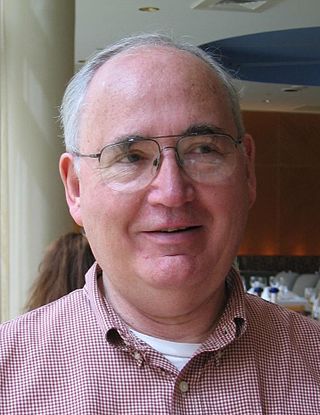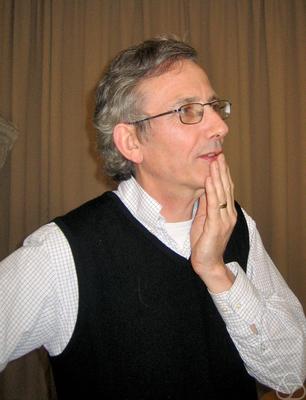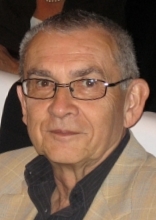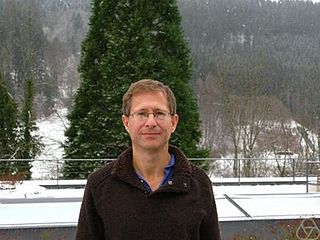Anand Pillay (born 7 May 1951) is a British mathematician and logician working in model theory and its applications in algebra and number theory.
Contents

Anand Pillay (born 7 May 1951) is a British mathematician and logician working in model theory and its applications in algebra and number theory.

Pillay studied as an undergraduate at the University of Oxford, obtaining a Bachelor in Mathematics and Philosophy in 1973 at Balliol College. At the University of London, he received his master's degree in mathematics in 1974 and his PhD in 1978 with Wilfrid Hodges at Bedford College, titled Gaifman Operations, Minimal Models, and the Number of Countable Models. [1] In 1978, he was a Royal Society Fellow and visiting scientist at CNRS at Paris Diderot University. After teaching at the University of Manchester starting in 1981 and at McGill University in Canada, he joined the University of Notre Dame as an assistant professor in 1983, where he became an associate professor in 1986 and a full professor in 1988. From 1996 to 2006, he was Swanlund Professor at the University of Illinois Urbana-Champaign, where he is now Professor Emeritus. Since 2005, he has been the Chair of Mathematical Logic at the University of Leeds. He also held positions as a visiting scholar at the Fields Institute in Toronto, at the Mathematical Sciences Research Institute in Berkeley, and at the Isaac Newton Institute in Cambridge.
Pillay's dissertation work concerned the number of countable models of countable theories; under the influence of the Paris school of model theory, he also worked on stability theory. Later, he dealt with applications of model theory in other areas of mathematics, including Nash manifolds and groups, algebraic theory of differential equations and differential algebra, classification of compact complex manifolds, and diophantine geometry.
Pillay was an invited speaker at the International Congress of Mathematicians in Zürich in 1994. In 2009 he was invited to present the Tarski Lectures, titled Compact Spaces, Definability, and Measures, in Model Theory. His three lectures were titled "The Logic Topology", "Lie Groups from Nonstandard Models", and "Measures and Domination". [2] In 2001, he received the Humboldt Foundation's research award, and was also a Humboldt Fellow at the University of Kiel in 1988 and at the University of Freiburg in 1992. In 2011, he gave the Gödel Lecture. He is a Fellow of the American Mathematical Society.

Discrete mathematics is the study of mathematical structures that can be considered "discrete" rather than "continuous". Objects studied in discrete mathematics include integers, graphs, and statements in logic. By contrast, discrete mathematics excludes topics in "continuous mathematics" such as real numbers, calculus or Euclidean geometry. Discrete objects can often be enumerated by integers; more formally, discrete mathematics has been characterized as the branch of mathematics dealing with countable sets. However, there is no exact definition of the term "discrete mathematics".
In mathematical logic, model theory is the study of the relationship between formal theories, and their models. The aspects investigated include the number and size of models of a theory, the relationship of different models to each other, and their interaction with the formal language itself. In particular, model theorists also investigate the sets that can be defined in a model of a theory, and the relationship of such definable sets to each other. As a separate discipline, model theory goes back to Alfred Tarski, who first used the term "Theory of Models" in publication in 1954. Since the 1970s, the subject has been shaped decisively by Saharon Shelah's stability theory.

Alfred Tarski was a Polish-American logician and mathematician. A prolific author best known for his work on model theory, metamathematics, and algebraic logic, he also contributed to abstract algebra, topology, geometry, measure theory, mathematical logic, set theory, and analytic philosophy.

Dana Stewart Scott is an American logician who is the emeritus Hillman University Professor of Computer Science, Philosophy, and Mathematical Logic at Carnegie Mellon University; he is now retired and lives in Berkeley, California. His work on automata theory earned him the Turing Award in 1976, while his collaborative work with Christopher Strachey in the 1970s laid the foundations of modern approaches to the semantics of programming languages. He has worked also on modal logic, topology, and category theory.

Sir Simon Kirwan Donaldson is an English mathematician known for his work on the topology of smooth (differentiable) four-dimensional manifolds, Donaldson–Thomas theory, and his contributions to Kähler geometry. He is currently a permanent member of the Simons Center for Geometry and Physics at Stony Brook University in New York, and a Professor in Pure Mathematics at Imperial College London.
In mathematical logic, Morley rank, introduced by Michael D. Morley (1965), is a means of measuring the size of a subset of a model of a theory, generalizing the notion of dimension in algebraic geometry.

Yuri Ivanovich Manin was a Russian mathematician, known for work in algebraic geometry and diophantine geometry, and many expository works ranging from mathematical logic to theoretical physics.

Ehud Hrushovski is a mathematical logician. He is a Merton Professor of Mathematical Logic at the University of Oxford and a Fellow of Merton College, Oxford. He was also Professor of Mathematics at the Hebrew University of Jerusalem.

Robert Lawson Vaught was a mathematical logician and one of the founders of model theory.

Phillip Augustus Griffiths IV is an American mathematician, known for his work in the field of geometry, and in particular for the complex manifold approach to algebraic geometry. He is a major developer in particular of the theory of variation of Hodge structure in Hodge theory and moduli theory, which forms part of transcendental algebraic geometry and which also touches upon major and distant areas of differential geometry. He also worked on partial differential equations, coauthored with Shiing-Shen Chern, Robert Bryant and Robert Gardner on Exterior Differential Systems.

Alan David Weinstein is a professor of mathematics at the University of California, Berkeley, working in the field of differential geometry, and especially in Poisson geometry.

Alex James Wilkie FRS is a British mathematician known for his contributions to model theory and logic. Previously Reader in Mathematical Logic at the University of Oxford, he was appointed to the Fielden Chair of Pure Mathematics at the University of Manchester in 2007.

Angus John Macintyre FRS, FRSE is a British mathematician and logician who is a leading figure in model theory, logic, and their applications in algebra, algebraic geometry, and number theory. He is Emeritus Professor of Mathematics, at Queen Mary University of London.
In the mathematical field of model theory, a theory is called stable if it satisfies certain combinatorial restrictions on its complexity. Stable theories are rooted in the proof of Morley's categoricity theorem and were extensively studied as part of Saharon Shelah's classification theory, which showed a dichotomy that either the models of a theory admit a nice classification or the models are too numerous to have any hope of a reasonable classification. A first step of this program was showing that if a theory is not stable then its models are too numerous to classify.

Zlil Sela is an Israeli mathematician working in the area of geometric group theory. He is a Professor of Mathematics at the Hebrew University of Jerusalem. Sela is known for the solution of the isomorphism problem for torsion-free word-hyperbolic groups and for the solution of the Tarski conjecture about equivalence of first-order theories of finitely generated non-abelian free groups.
Mathematics is a broad subject that is commonly divided in many areas that may be defined by their objects of study, by the used methods, or by both. For example, analytic number theory is a subarea of number theory devoted to the use of methods of analysis for the study of natural numbers.

Laurentius Petrus Dignus "Lou" van den Dries is a Dutch mathematician working in model theory. He is a professor emeritus of mathematics at the University of Illinois at Urbana–Champaign.
The Gödel Lecture is an honor in mathematical logic given by the Association for Symbolic Logic, associated with an annual lecture at the association's general meeting. The award is named after Kurt Gödel and has been given annually since 1990.
The Colloquium Lecture of the American Mathematical Society is a special annual session of lectures.